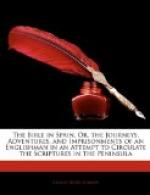O how pleasant it is, especially in springtide, to stray along the shores of the Guadalquivir. Not far from the city, down the river, lies a grove called Las Delicias, or the Delights. It consists of trees of various kinds, but more especially of poplars and elms, and is traversed by long shady walks. This grove is the favourite promenade of the Sevillians, and there one occasionally sees assembled whatever the town produces of beauty or gallantry. There wander the black-eyed Andalusian dames and damsels, clad in their graceful silken mantillas; and there gallops the Andalusian cavalier, on his long-tailed thick-maned steed of Moorish ancestry. As the sun is descending, it is enchanting to glance back from this place in the direction of the city; the prospect is inexpressibly beautiful. Yonder in the distance, high and enormous, stands the Golden Tower, now used as a toll-house, but the principal bulwark of the city in the time of the Moors. It stands on the shore of the river, like a giant keeping watch, and is the first edifice which attracts the eye of the voyager as he moves up the stream to Seville. On the other side, opposite the tower, stands the noble Augustine convent, the ornament of the faubourg of Triana, whilst between the two edifices rolls the broad Guadalquivir, bearing on its bosom a flotilla of barks from Catalonia and Valencia. Farther up is seen the bridge of boats which traverses the water. The principal object of this prospect, however, is the Golden Tower, where the beams of the setting sun seem to be concentrated as in a focus, so that it appears built of pure gold, and probably from that circumstance received the name which it now bears. Cold, cold must the heart be which can remain insensible to the beauties of this magic scene, to do justice to which the pencil of Claude himself were barely equal. Often have I shed tears of rapture whilst I beheld it, and listened to the thrush and the nightingale piping forth their melodious songs in the woods, and inhaled the breeze laden with the perfume of the thousand orange gardens of Seville:
“Kennst du das land wo die citronem bluhen?”
The interior of Seville scarcely corresponds with the exterior: the streets are narrow, badly paved, and full of misery and beggary. The houses are for the most part built in the Moorish fashion, with a quadrangular patio or court in the centre, where stands a marble fountain, constantly distilling limpid water. These courts, during the time of the summer heats, are covered over with a canvas awning, and beneath this the family sit during the greater part of the day. In many, especially those belonging to the houses of the wealthy, are to be found shrubs, orange trees, and all kinds of flowers, and perhaps a small aviary, so that no situation can be conceived more delicious than to lie here in the shade, hearkening to the song of the birds and the voice of the fountain.




